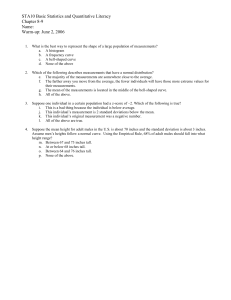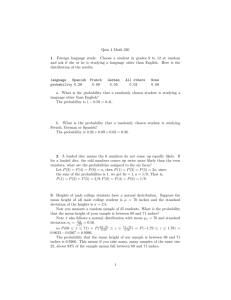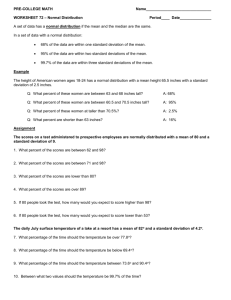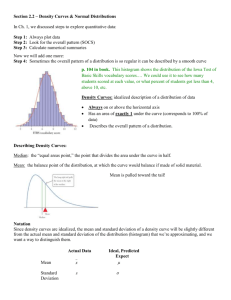Test 2A
advertisement
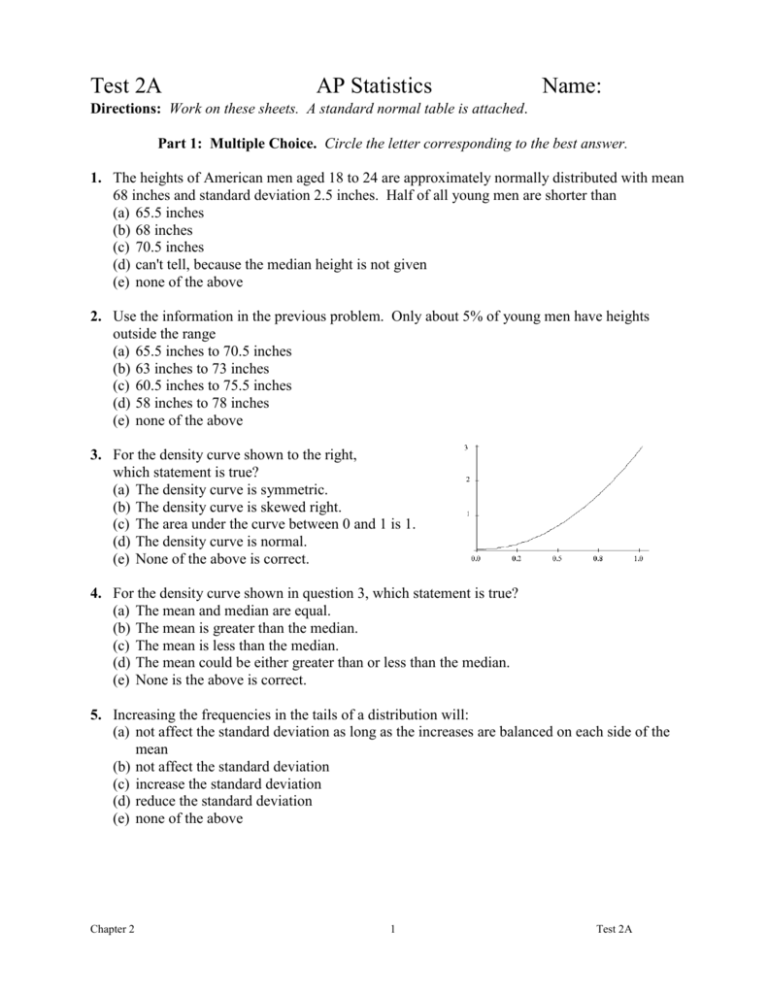
Test 2A AP Statistics Name: Directions: Work on these sheets. A standard normal table is attached. Part 1: Multiple Choice. Circle the letter corresponding to the best answer. 1. The heights of American men aged 18 to 24 are approximately normally distributed with mean 68 inches and standard deviation 2.5 inches. Half of all young men are shorter than (a) 65.5 inches (b) 68 inches (c) 70.5 inches (d) can't tell, because the median height is not given (e) none of the above 2. Use the information in the previous problem. Only about 5% of young men have heights outside the range (a) 65.5 inches to 70.5 inches (b) 63 inches to 73 inches (c) 60.5 inches to 75.5 inches (d) 58 inches to 78 inches (e) none of the above 3. For the density curve shown to the right, which statement is true? (a) The density curve is symmetric. (b) The density curve is skewed right. (c) The area under the curve between 0 and 1 is 1. (d) The density curve is normal. (e) None of the above is correct. 4. For the density curve shown in question 3, which statement is true? (a) The mean and median are equal. (b) The mean is greater than the median. (c) The mean is less than the median. (d) The mean could be either greater than or less than the median. (e) None is the above is correct. 5. Increasing the frequencies in the tails of a distribution will: (a) not affect the standard deviation as long as the increases are balanced on each side of the mean (b) not affect the standard deviation (c) increase the standard deviation (d) reduce the standard deviation (e) none of the above Chapter 2 1 Test 2A 6. For the density curve shown, what is the mean? (a) 0 (b) 0.25 (c) 0.50 (d) 0.75 (e) None of the above 7. A smooth curve which approximates the shape of a histogram and describes the overall pattern of a distribution is called (a) a stemplot (b) a normal plot (c) a normal probability plot (d) a density curve (e) none of the above 8. A normal density curve has which of the following properties? (a) It is symmetric. (b) It has a peak centered above its mean. (c) The spread of the curve is proportional to it standard deviation. (d) All of the properties, (a) to (c), are correct. (e) None of the properties, (a) to (c), is correct. 9. The area under the standard normal curve corresponding to –0.3<Z<1.6 is (a) 0.3273 (b) 0.4713 (c) 0.5631 (d) 0.9542 (e) None of the above 10. Which of the following histograms would be best approximated by a normal distribution: (a) (b) (c) (d) Chapter 2 2 Test 2A Part 2: Free Response Answer completely, but be concise. Write sequentially and show all steps. 11. We all “know” that the body temperature of a healthy person is 98.6 °F. In reality, the actual body temperature of individuals varies. Here are boxplots, produced by Minitab, for the body temperatures of 130 individuals (65 males and 65 females). Gender 1 2 * * * Temps 96.0 97.2 98.4 99.6 100.8 (a) Here’s a normal probability plot of the temperature of the males. Explain how it justifies assuming the temperature of the male population is normally distributed. (b) According to Minitab, µ = 98.103 and = 0.700 for the male temperatures. If we assume that the males’ temperatures were normally distributed, what percent would have temperatures at 98.7 or above? 12. The best male long jumpers for State College since 1973 have averaged a jump of 263.0 inches with a standard deviation of 14.0 inches. The best female long jumpers have averaged 201.2 inches with a standard deviation of 7.7 inches. This year Joey jumped 275 inches and his sister, Carla, jumped 207 inches. Both are State College students. Assume that male and female jumps are normally distributed. Within their groups, which athlete had the more impressive performance? Explain briefly. Chapter 2 3 Test 2A 13. The length of pregnancies from conception to natural birth among a certain female population is a normally distributed random variable with mean 270 and standard deviation 10 days. (a) What is the percent of pregnancies that last more than 300 days? (b) How short must a pregnancy be in order to fall in the shortest 10% of all pregnancies? 14. For a normally distributed population, fill in the following blanks: (a) % of the population observations lie within 1.96 standard deviations on either side of the mean. (b) % of the population observations lie within 1.64 standard deviations on either side of the mean. I pledge that I have neither given nor received aid on this test._________________________ Chapter 2 4 Test 2A Chapter 2 5 Test 2A
